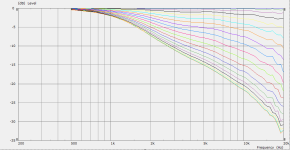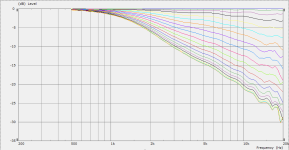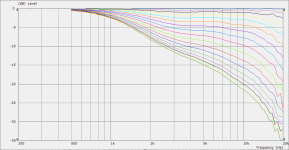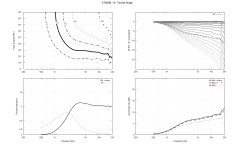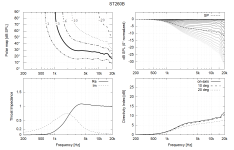Actually, no, the extension should be longer, I think. The slight mismatches of the angles are no disaster (and it's always better to move them to closer to the smaller diameter, if they can't be avoided, IMHO). The length of the extension has probably a lot greater effect - hopefully possitive in this case. As I said eariler, I would first try the whole device as it is provided. We're still in the cut&try teritory here...
Hello @mabat,
Thank you for all your work on ATH.
I was hoping to use the ST260B as a starting point (flush mounted system) and match the throat angle to my compression driver's exit (BMS 4550) and also experiment with squashing the waveguide into slightly non-axisymmetric shapes for C2C space reasons.
Did you ever end up sharing the definition file for that one? I tried to use the search/filters extensively, but have not been able to find it.
I wanted to PM you, but my account is new and so is "under moderation"... I'm unable to send PMs.
Many thanks
Thank you for all your work on ATH.
I was hoping to use the ST260B as a starting point (flush mounted system) and match the throat angle to my compression driver's exit (BMS 4550) and also experiment with squashing the waveguide into slightly non-axisymmetric shapes for C2C space reasons.
Did you ever end up sharing the definition file for that one? I tried to use the search/filters extensively, but have not been able to find it.
I wanted to PM you, but my account is new and so is "under moderation"... I'm unable to send PMs.
Many thanks
You would have to reverse-engineer the existing one, with a OSSE or a part of R-OSSE formula.
Today a had a though about waveguides out of nowhere. So, here we go 🙂
The beamwidth of the sound depends on the diameter of the source. I had this mental image of the sound from the throat following the waveguide, until it lets go of the waveguide and travels onwards as if there is no waveguide. The place/diameter at which this happens depends on the wavelength of the sound.
If you want the sound to have the same beamwidth (resulting in a flat DI), the waveguide needs to be the same at every scale. For a slightly increasing DI one might need to morph the shape a bit.
The logarithmic spiral is a self similar spiral (by rotation).
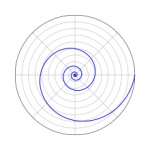
What do you guys think, is it worth the effort to investigate this brainwave? I'm a bit rusty, so it would take me some time...
The beamwidth of the sound depends on the diameter of the source. I had this mental image of the sound from the throat following the waveguide, until it lets go of the waveguide and travels onwards as if there is no waveguide. The place/diameter at which this happens depends on the wavelength of the sound.
If you want the sound to have the same beamwidth (resulting in a flat DI), the waveguide needs to be the same at every scale. For a slightly increasing DI one might need to morph the shape a bit.
The logarithmic spiral is a self similar spiral (by rotation).

What do you guys think, is it worth the effort to investigate this brainwave? I'm a bit rusty, so it would take me some time...
I'm sceptical about getting a flat DI from such shape. For a flat DI, you need someting more like a cone (which is also self-similar), big enough. And of course you need to terminate it smoothly. I think we've been there already 🙂
Mold for making the horn out of fiberglass almost finished
You would have to reverse-engineer the existing one, with a OSSE or a part of R-OSSE formula.
@mabat I actually found the parameters - you shared them in post #9,135. It seems to work fine as OS-SE.
Attached are some sims with the modified throat angle and also one with an elliptical mouth with roughly a 50° coverage in the V plane, along with the original you posted for comparison.
Nothing to worry about directivity-wise, IMO. The speaker-to-room path in my room is nearly anechoic.
It's hard to say whether the increased jaggedness in the modified version is due to the actual horn behaviour or different ABEC settings.
What I am interested in optimizing, however, is diffraction in the device. I know there seems to be a trade-off between diffraction and beaming as shown in this post #11,252 by @tmuikku for example, but I don't fully comprehend the mechanism of that trade-off.
The use case here is critical listening in a very dead room and so the power response basically holds no weight. I'd be happy to trade a bit of beaming for increased smoothness/cleaner time response.
The examples posted by @mabat and @tmuikku around #11,252 are using R-OSSE and tweaking the parameter tmax, which of course isn't applicable to OS-SE, which is what I'm using because the system is to be flush mounted. "Sound around the device" is also not at play in this case, of course.
Would anybody be willing to make the nature of this trade-off more clear to me and/or share some tips on which parameters to tweak in order to play with this in an infinite baffle situation? (if it's even possible 😕)
Attachments
Hi, sorry no time to check the posts you referred to. Here is the general idea: diffraction happens anywhere along the curve, where there is a sudden change in thw curve, mouth edgebeing tge most obvious oneon a freestanding waveguide, or baffle edge in any boxed speaker.
Mabat's formula is continuous curve, which the tmax parameter can extend all beyond typical use case. The dea is to remove even the mouth edge, wrap the profile all the wsy around.
Beaming relates to making a narrow coverage device with low diffraction backside/mouth. If you play with the stuff in desmos you'll get intuition why. If you are fine with wide coverage, it's possible to have low diffraction curve that doesn't beam.
Besides tmax the backside can be made otherwise, with additional curve.But, interface to rosse/osse curve easily diffracts some them, as it's not continuous anymore.
I'm not sure if small diffraction is audible, I think it's not, as long as you perceive nice non-changing sound with head moving. The sound would change due to stereo crosstalk between ears,ä masking it, but if you keep your head still and rotate the speakers then it should stay smooth.
If you do sound work you likely know how important high frequency magnitude is to you (EQ), how small of a change you think is important. If you get waveguide frequency response ripple below this, your threshold of importance, you'd be good I think.
For example st260 I'm currently listening shows some ripple, and uses diffraction to extend hogh DI lower in frequency and it sounds fine. I haven't yet made device with the backside so have no idea if it sounds any better. If either sounds better it is likely more to system design and implementation, rather than the very small ripple difference.
I hope this helps forward with you project! have fun!
Mabat's formula is continuous curve, which the tmax parameter can extend all beyond typical use case. The dea is to remove even the mouth edge, wrap the profile all the wsy around.
Beaming relates to making a narrow coverage device with low diffraction backside/mouth. If you play with the stuff in desmos you'll get intuition why. If you are fine with wide coverage, it's possible to have low diffraction curve that doesn't beam.
Besides tmax the backside can be made otherwise, with additional curve.But, interface to rosse/osse curve easily diffracts some them, as it's not continuous anymore.
I'm not sure if small diffraction is audible, I think it's not, as long as you perceive nice non-changing sound with head moving. The sound would change due to stereo crosstalk between ears,ä masking it, but if you keep your head still and rotate the speakers then it should stay smooth.
If you do sound work you likely know how important high frequency magnitude is to you (EQ), how small of a change you think is important. If you get waveguide frequency response ripple below this, your threshold of importance, you'd be good I think.
For example st260 I'm currently listening shows some ripple, and uses diffraction to extend hogh DI lower in frequency and it sounds fine. I haven't yet made device with the backside so have no idea if it sounds any better. If either sounds better it is likely more to system design and implementation, rather than the very small ripple difference.
I hope this helps forward with you project! have fun!
Last edited:
For a flush-mounted system, the OS-SE is pretty good, as it have a smoothly decreasing curvature (basically to zero) towards the edge, where a flat wall continues. The smoother the curvature change (i.e. the bigger the overall mouth "roundover" - bigger s and possibly q), the better. So make the waveguide itself as large as possible. That's by far the biggest effect, IMHO.
I would like to use the equations generously shared by mabat to generate a roundover profile for my large nine sided (or the next eight sided) conical horn https://www.diyaudio.com/community/threads/nine-sided-conical-horn-meh.407394/page-5#post-7588374
I need a profile that has a defined thickness and width, as I cannot 3D machine more than ca 50 cm high parts. Would there be any recommended values for this? Or should I just play with the sliders until I have something nice to the eye and fitting the CNC since all results have a smooth curvature change?
Would there be a way to generate files by ATH for ABEC for such a horn? 18 mm thick adapter, then a long conical part and then a roundover added? I would assume axisymmetrical simulation would be fine here.
Also, I can imagine that one could generate a better transition for the throat part using ATH - even if it is only 18 mm thick (might be actually up to 50 mm thick with some effort) and needs to transition from round to a nonagon (or octagon for the future one) on that length like in the AthHex horn.
Any suggestions would be highly appreciated!
I need a profile that has a defined thickness and width, as I cannot 3D machine more than ca 50 cm high parts. Would there be any recommended values for this? Or should I just play with the sliders until I have something nice to the eye and fitting the CNC since all results have a smooth curvature change?
Would there be a way to generate files by ATH for ABEC for such a horn? 18 mm thick adapter, then a long conical part and then a roundover added? I would assume axisymmetrical simulation would be fine here.
Also, I can imagine that one could generate a better transition for the throat part using ATH - even if it is only 18 mm thick (might be actually up to 50 mm thick with some effort) and needs to transition from round to a nonagon (or octagon for the future one) on that length like in the AthHex horn.
Any suggestions would be highly appreciated!
I think it should be possible with the Throat.Ext.* definitions in Ath - for the truly conical part.
The remaining roundover could be just a R-OSSE profile, starting with more or less conical shape (a = a0): https://www.desmos.com/calculator/j0lcqjaccy
It's even possible to simulate an 8-segment horn simply by setting Mesh.AngularSegments = 8, I think.
The remaining roundover could be just a R-OSSE profile, starting with more or less conical shape (a = a0): https://www.desmos.com/calculator/j0lcqjaccy
It's even possible to simulate an 8-segment horn simply by setting Mesh.AngularSegments = 8, I think.
Was the kit version of this ever released?I'm still improving the geometry, it's now better than ever. Some new things, I just don't have the time for reporting. I hope to provide a new STL kit soon.
⌀280mm extended waveguide -
View attachment 1259594 View attachment 1259593
I have it almost ready. This time it's very easy to print and assemble (it will need M5 thread inserts).


Last edited:
This is the core shape. Any custom mounting, if desired, should be easy to add.


Thanks @tmuikku and @mabat for the info/suggestions! I'll give it a go and see how far I can minimize ripple.
The ultimate would indeed be to somehow know where the audibility thresholds are for these very early reflections/diffractions. My intuition is that it would be more audible in a room where almost all other sources of reflections are removed like this, but naturally I don't have the means to test the environment with and without reflections in a rapid, properly controlled manner.
I imagine that inspecting the impulse response for a given angle would be helpful when hunting for diffractions. Did anyone end up having success in deriving IRs from the simulated data via IFFT?
The ultimate would indeed be to somehow know where the audibility thresholds are for these very early reflections/diffractions. My intuition is that it would be more audible in a room where almost all other sources of reflections are removed like this, but naturally I don't have the means to test the environment with and without reflections in a rapid, properly controlled manner.
I imagine that inspecting the impulse response for a given angle would be helpful when hunting for diffractions. Did anyone end up having success in deriving IRs from the simulated data via IFFT?
Fantastic, very much looking forward to that!I have it almost ready. This time it's very easy to print and assemble (it will need M5 thread inserts).
@mabat: I don't have any compression drivers yet - would you have the CAD file STL for an insert into the driver town to its phase plug for a suitable driver?
I must be doing something wrong. I somehow fail to have the throat extension generated for simulation. This is my cfg file with parameters matching the conical horn I built, I am using ATH 4.8.2. This file generates only the roundover profile - which is a great thing and exactly what I need. Could I please ask to check the file where the problem is?
Attachments
@mabat Thanks for the calc software it is heaps of fun to play with. 🙂
A feature request if you get bored...
I have been delving a little deeper into Spherical Wave Forming and was wondering about using similar ideas for path equalisation for phase plugs and other speaker related shenanigans. Is there a way of making the ESP definition more generic? I believe that a bit of refactoring could make selecting in/out planar/spherical and ability to make specifying in/out points in 2d space rather than having them fit a line/curve possible and that would make this sure useful for designing all manner of path length corrections/manipulations.
Thanks for the software!!!
A feature request if you get bored...
I have been delving a little deeper into Spherical Wave Forming and was wondering about using similar ideas for path equalisation for phase plugs and other speaker related shenanigans. Is there a way of making the ESP definition more generic? I believe that a bit of refactoring could make selecting in/out planar/spherical and ability to make specifying in/out points in 2d space rather than having them fit a line/curve possible and that would make this sure useful for designing all manner of path length corrections/manipulations.
Thanks for the software!!!
- Home
- Loudspeakers
- Multi-Way
- Acoustic Horn Design – The Easy Way (Ath4)
